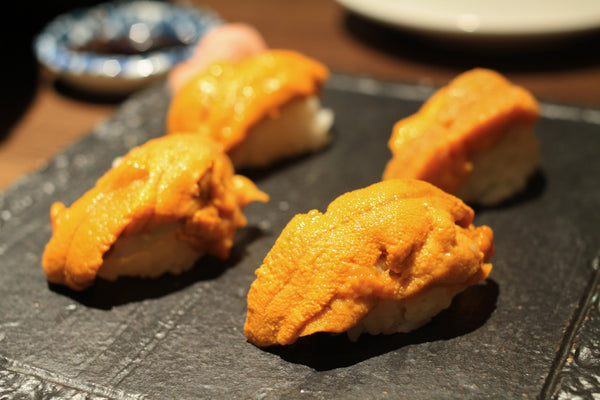
What Makes “Uni” Sea Urchin from Hokkaido So Special?
Share
Creamy, plump, rich in briny umami and with a gentle sweetness, uni (sea urchin) from Hokkaido is an absolute delicacy. Uni comes in several varieties and is harvested nationwide across Japan, but those from Hokkaido are particularly venerated and highly prized. What makes them so special? Here we decipher the secrets behind the exceptional quality of uni from the northern island of Japan.

Raised on Premium Kombu Kelp
Great quality comes from great feed! The oceans surrounding Hokkaido offer an abundance of premium kombu kelp that uni eat—Hokkaido actually accounts for over 90% of Japan’s kombu production. Highly valued kombu, such as Rausu Kombu, Hidaka Kombu, Rishiri Kombu, Makombu, and Hosome Kombu, are all grown in the cold waters of Hokkaido, and those umami-rich, premium kombu contribute to Hokkaido uni’s remarkable quality and taste. Each of the aforementioned kombu varieties is nurtured in its own unique marine climate, which not only determines its special character but also ultimately the taste of uni that eat it.

Hokkaido’s Rich and Complex Ocean Environments
Hokkaido is surrounded by three seas; the Sea of Japan on the west, the Sea of Okhotsk on the north, and the Pacific Ocean on the southeast of the island’s coast, and both cold and warm currents flow into these areas. This dynamic environment makes the waters around Hokkaido particularly rich and complex and it supports healthy plankton populations. Kombu eat plankton, then uni eat kombu, and this food chain results in Hokkaido uni developing their multilayered flavors and smooth texture. Even within Hokkaido, marine climates vary widely depending on location, creating regional features—for instance, the Rishiri-Rebun area is known for robust, buttery Ezo Bafun Uni and firm, sweet Kita Murasaki Uni while the Shakotan region provides rich, creamy Bafun Uni and light, delicate Murasaki Uni.

Seasonal Uni All Year Round
Uni’s peak season commonly lasts 2-3 months, but because Hokkaido offers several uni producing areas with different harvesting periods, high quality uni can be produced all year round! Major areas and harvesting periods are: Rausu (January-June), Erimo-Hidaka (March-May), Rishiri-Rebun, Shakotan, Otaru, and Iwanai (June-August), Esashi (May-July), Okushiri Island (July-August), and Matsumae (September-December).

Four Uni Varieties Harvested in Hokkaido
Bafun Uni
This yellowish-orange uni exhibits a superbly rich, bold, and creamy texture and an elegant sweetness. It is grown in other regions in Japan as well, so it’s one of the most common uni varieties in Japan.

Ezo Bafun Uni
Ezo Bafun Uni—“Ezo” means Hokkaido—is bigger than Bafun Uni and boasts a robust flavor, intense umami and sweetness. It has a buttery texture that melts in your mouth. Because of its deep orange color, luxurious taste, and sizable roe, it is prized as “the best quality uni”. This variety is mainly harvested in Hokkaido as the name suggests.

Murasaki Uni
This uni, with a bright yellow color, is characterized by a firm texture, elegant sweetness and a pleasant brininess. Because it’s grown nationwide across Japan, the taste profile varies from region to region.

Kita Murasaki Uni
“Kita” means north, and this uni is mainly harvested in northern areas including Hokkaido. The northern specialty uni boasts plump, firm roe and a gentle, elegant sweetness. Because of these characteristics

